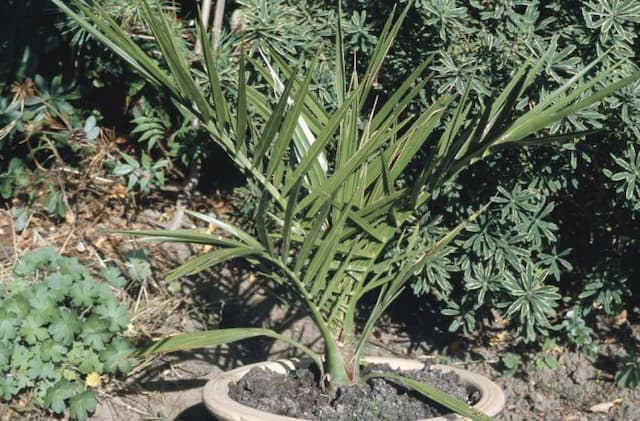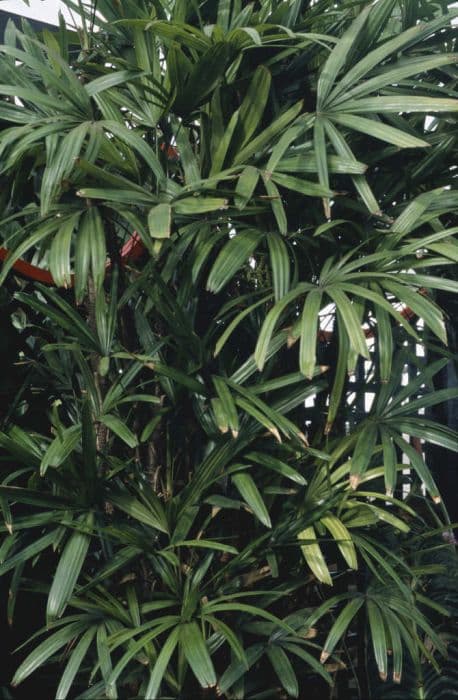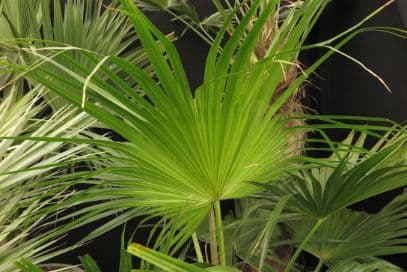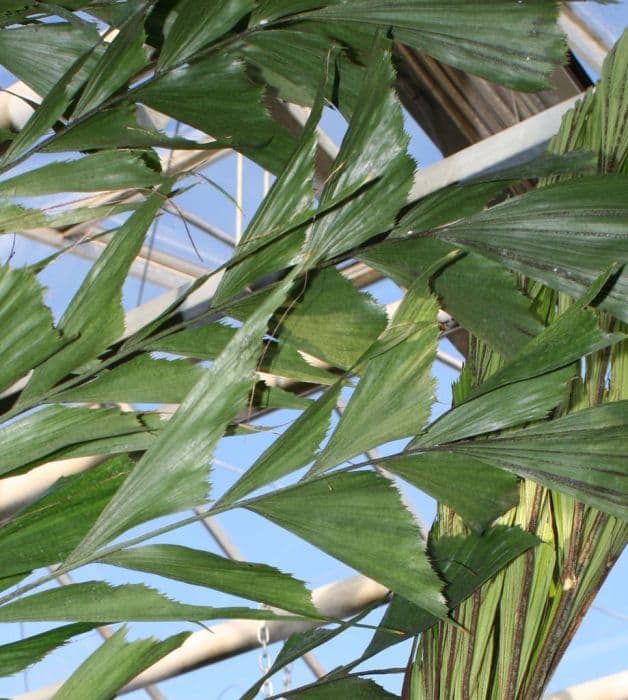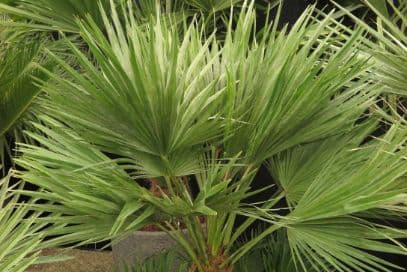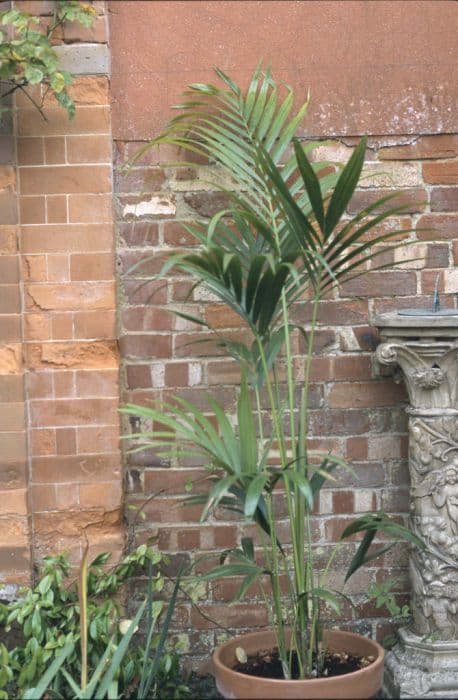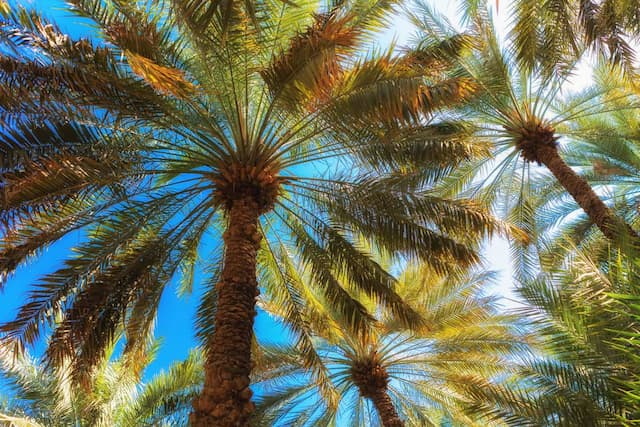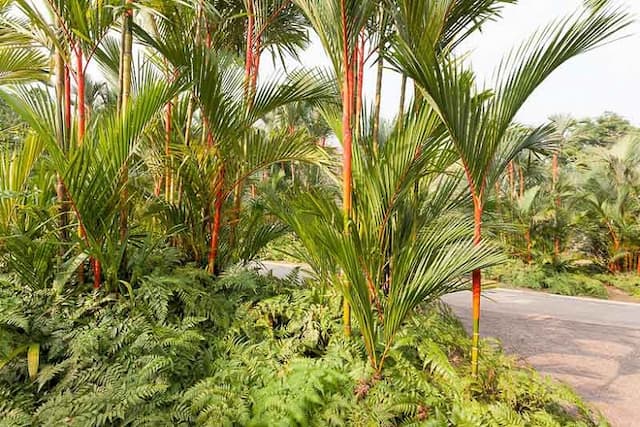Mexican Blue Palm Brahea armata
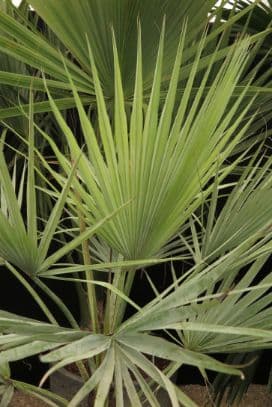
ABOUT
The Mexican Blue Palm, also known as the Blue Hesper Palm due to its striking bluish-gray leaves, presents a unique and stunning appearance in the landscape. This palm is easily identifiable by its large, stiff, and fan-shaped fronds which form a rounded crown at the top of the plant. Each frond exhibits a silvery-blue hue, owing to a waxy coating on its surface, giving the plant an almost metallic luster. The fronds of the Mexican Blue Palm are also known for the sharp spines that line the edges of their petioles, providing a measure of protection. Contrasting the blue foliage, the plant produces clusters of small, cream-colored flowers on long, hanging stalks known as inflorescences, which drape below the canopy of fan leaves. These blossoms are followed by small, round fruits that add further interest to the plant's profile. The trunk of the Mexican Blue Palm is notable for its stout and sturdy structure with a textured pattern that serves as a testament to the plant's previous growth, as each leaf scar represents a frond that was once attached. With its contrasting shades and robust silhouette, the Mexican Blue Palm brings a touch of exotic beauty and sculptural elegance to gardens and landscapes where it is showcased. Its distinctive blue foliage and overall form make it a popular choice for gardeners looking to add an eye-catching focal point to their outdoor spaces.
About this plant
 Names
NamesFamily
Arecaceae.
Synonyms
Mexican Blue Palm, Blue Hesper Palm, Grey Goddess, Blue Fan Palm.
Common names
Brahea armata, Erythea armata.
 Toxicity
ToxicityTo humans
Blue Hesper Palm is not known to be toxic to humans. There are no significant reports of poisoning or adverse reactions from ingesting any parts of this plant.
To pets
Blue Hesper Palm is also not known to be toxic to pets. There are no prevalent symptoms or consequences associated with the ingestion of any part of the plant by household pets.
 Characteristics
CharacteristicsLife cycle
Perennials
Foliage type
Evergreen
Color of leaves
Silver-blue
Flower color
White
Height
40 feet (12 meters)
Spread
15 feet (4.5 meters)
Plant type
Palm
Hardiness zones
8
Native area
Mexico
Benefits
 General Benefits
General Benefits- Drought Tolerance: The Mexican Blue Palm is highly adapted to arid environments, requiring minimal watering once established.
- Landscaping Aesthetic: Its striking blue-gray fronds and compact crown provide a unique and exotic look for gardens and public spaces.
- Shade Provision: It can offer a cooling area of shade in hot climates, making outdoor areas more comfortable.
- Low Maintenance: The plant requires little pruning or additional care, which makes it ideal for people looking for a low-maintenance garden option.
- Salt Tolerance: It is well-suited for coastal environments as it can tolerate salty soils and sea spray.
- Wildlife Habitat: It can provide food and shelter for various species of birds and other wildlife.
- Wind Resistance: The robust structure of the palm allows it to withstand strong winds, making it a good choice for exposed locations.
- Long Lifespan: With the right conditions, it can live for several decades, providing a long-term feature for landscapes.
- Cultural Significance: In its native range, it may have cultural importance and be used in traditional landscaping.
 Medical Properties
Medical PropertiesThis plant is not used for medical purposes.
 Air-purifying Qualities
Air-purifying QualitiesThis plant is not specifically known for air purifying qualities.
 Other Uses
Other Uses- Brahea armata, commonly known as the Mexican Blue Palm, can provide a habitat for various wildlife species. Its dense foliage and height offer nesting sites for birds and shelter for other small animals.
- The strong fibers from its leaves can be harvested and used to make brooms, brushes, or ropes in traditional crafts.
- The Mexican Blue Palm can be utilized in landscape design for creating dramatic night lighting effects due to its silvery-blue foliage that reflects moonlight or artificial lighting beautifully.
- The seeds of the Mexican Blue Palm may be ground and used as a substitute for coffee, though this practice is not widespread and should be researched for safety before consumption.
- The dried fronds of the palm can be used in thematic decorations or costumes, especially for beach or tropical-themed parties and events.
- In arid regions, the Mexican Blue Palm is often used as a windbreak or to stabilize soil, owing to its sturdy root system and tolerance for dry conditions.
- The sap of the palm can be fermented to produce an alcoholic beverage, similar to how sap from other palm species is used to make palm wine.
- The thick trunk of the Mexican Blue Palm can be carved or hollowed out post-harvest to create unique natural planters or decorative items.
- During the Christmas season in certain regions, the fronds may be used as a substitute for pine boughs to create wreaths and garlands.
- The husk of the palm's fruit has been traditionally used as a dye in some cultures, imparting a tan or brown color to textiles.
Interesting Facts
 Feng Shui
Feng ShuiThe Mexican Blue Palm is not used in Feng Shui practice.
 Zodiac Sign Compitability
Zodiac Sign CompitabilityThe Mexican Blue Palm is not used in astrology practice.
 Plant Symbolism
Plant Symbolism- Resilience: The Brahea armata, commonly known as the Blue Hesper Palm, is known for its hardiness and ability to thrive in arid, desert-like conditions, symbolizing the capacity to endure and persist through tough times.
- Serenity: Its silvery-blue foliage brings to mind a sense of calm and tranquility, often representing peace and a soothing presence.
- Majesty: With its striking appearance and tall stature, the Blue Hesper Palm often symbolizes grandeur and a regal quality, reminiscent of its stately presence in landscapes.
- Longevity: As a species that can live for many decades, the Blue Hesper Palm embodies longevity and the passage of time.
- Protection: This palm has tough, fan-like leaves that can withstand harsh sun and wind, symbolizing protection and the ability to shield oneself from harm.
 Water
WaterThe Mexican Blue Palm should be watered deeply but infrequently to mimic its natural arid environment. Young trees benefit from watering once a week, allowing the soil to dry out between waterings. As the palm matures, decrease watering to twice a month, providing about 2 gallons of water each time for established palms. During the hot summer months, you can increase watering to support the plant's needs, but always allow the soil to dry before adding more water. Be cautious not to overwater, as this can lead to root rot.
 Light
LightThe Mexican Blue Palm thrives in full sun conditions and should be placed in a location where it can receive at least 6 to 8 hours of direct sunlight daily. A south-facing spot with unfiltered, intense sunlight is ideal for this palm to grow healthy and develop its characteristic blue-gray foliage. Avoid locations that are shaded for most of the day, as insufficient light can hinder its growth.
 Temperature
TemperatureThe Mexican Blue Palm prefers warm temperatures and can tolerate heat well, making it suitable for planting in USDA zones 8 to 11. The plant is hardy to about 15°F, but temperatures below 20°F may cause damage to the foliage. The ideal temperature range for this palm is between 65°F and 90°F. It is not frost-tolerant and should be protected or moved indoors if temperatures are expected to drop below its minimum tolerated level.
 Pruning
PruningPrune the Mexican Blue Palm to remove dead or damaged fronds and to maintain its striking appearance. Pruning is best done in the spring or early summer, when the plant is actively growing. You don't need to prune this palm frequently; once a year should be sufficient. Always use clean, sharp tools to make precise cuts and avoid cutting into the trunk, as that can cause damage to the plant.
 Cleaning
CleaningAs needed
 Soil
SoilThe Mexican Blue Palm (Brahea armata) thrives in well-draining soil with a pH range of 6.0 to 8.0. A soil mix composed of sand, loam, and a small amount of compost is ideal for this drought-tolerant plant. For the best growth, ensure the soil allows for good drainage to prevent root rot.
 Repotting
RepottingThe Mexican Blue Palm is a slow-growing plant and does not need frequent repotting. It typically requires repotting every three to five years. Larger specimens can be repotted even less frequently, as they may be tolerant of being root-bound.
 Humidity & Misting
Humidity & MistingMexican Blue Palm prefers dry atmospheric conditions and does well in low humidity levels typical of arid and semi-arid climates.
 Suitable locations
Suitable locationsIndoor
Place in bright light, allow soil to dry between waterings for the Mexican Blue Palm.
Outdoor
Plant in full sun, well-drained soil; protect from cold for Mexican Blue Palm.
Hardiness zone
8-11 USDA.
 Life cycle
Life cycleThe life cycle of the Brahea armata, commonly known as the Mexican Blue Palm or Blue Hesper Palm, begins with seed germination, which can be slow and irregular, often aided by heat and light. Once germinated, the seedling establishes a root system and a single shoot, developing into a juvenile palm with rigid, blue-green fan-shaped leaves. As it matures, the Blue Hesper Palm builds a stout, solitary trunk and the leaves form a canopy, with the distinctive waxy, bluish foliage providing drought resistance. Sexual maturity can take several years, after which the plant produces small white flowers on a large, branching inflorescence that can extend beyond the leaf canopy. Following pollination, likely by wind or insects, the palm produces small, black, edible fruits. With a lifespan that can exceed a century, the Blue Hesper Palm can go through multiple flowering and fruiting cycles while the slow growth rate results in a long period before reaching its full height of up to 50 feet (15 meters).
 Propogation
PropogationPropogation time
Spring to summer
The most popular method of propagation for the Blue Hesper Palm (Brahea armata) is through seeds. The best time for sowing seeds is in the spring or early summer when temperatures are warm, which aids in germination. To propagate by seeds, one should first soak the seeds for 24 to 48 hours in warm water to help soften the hard outer shell. After soaking, the seeds can be sown in a well-draining soil mix, at a depth of about 1 to 1.5 inches (2.5 to 3.8 centimeters), and then kept consistently moist but not waterlogged. Germination can be slow, often taking several months, and requires patience. Seedlings should only be transplanted after they have developed a robust root system.
